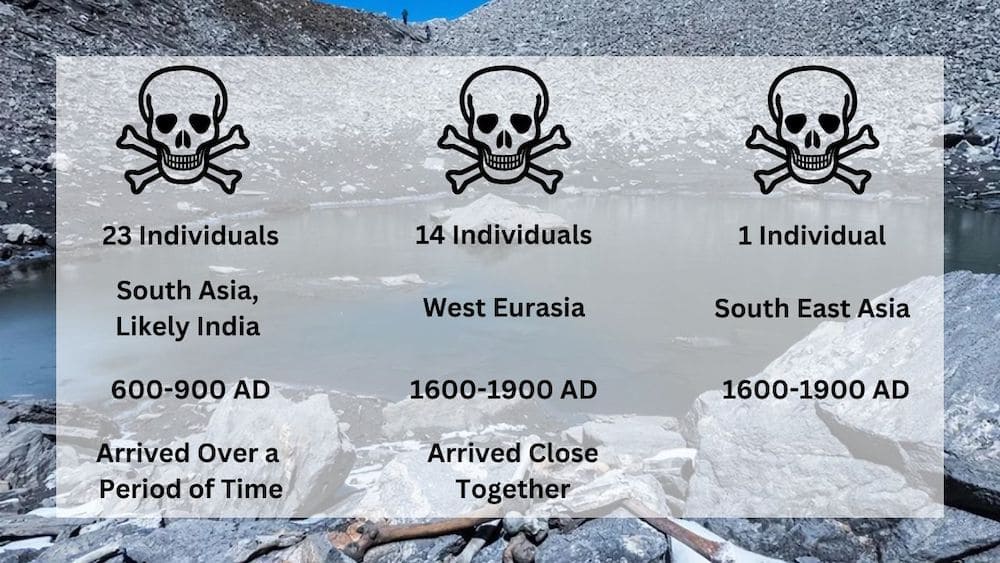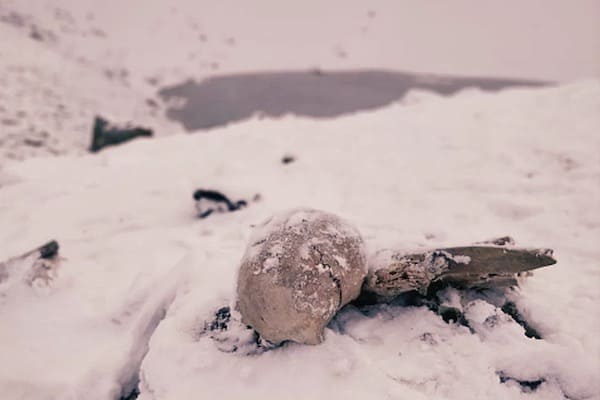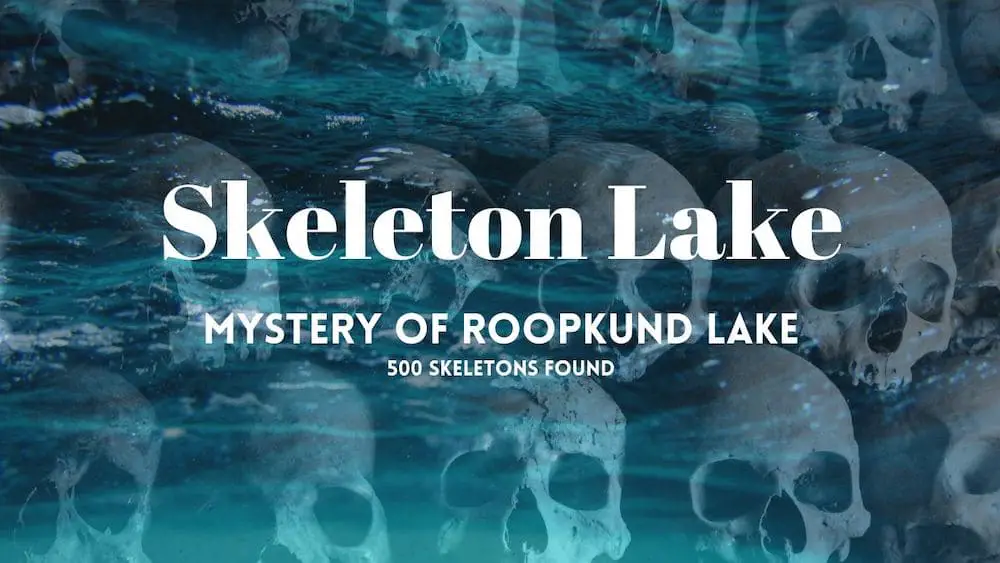A gruesome discovery was made in 1942. During the Second World War an Indian forest ranger named Hari Kishan Madwa discovered skeletons high in the Himalayas. What he discovered remains a mystery to this day. This is the story of Roopkund Lake in India. Or better known as Skeleton Lake.
At a height of over 5,000 meters, a tiny glacial lake with weird objects in its clear water became visible. As Hari Kishan approached the water, he found a large number of human skeletons in the lake. Little did he know he had found the famous Roopkund Lake.
This blog looks at Skeleton Lake and discusses one of my favorite mysteries about the Himalayas. Let’s dive into Roopkund Lake and the skeletons that lay at its shoreline.
Roopkund Lake – The Skeleton Lake in India:
The Roopkund Lake, also referred to as the Skeletons Lake or the enigmatic Skeleton Lake, is located within the Chamoli district of Uttarakhand, India. Perched at an altitude of 16,470 feet (5,020 meters) above sea level, this high-altitude glacier-fed lake is cradled amidst the Garhwal Himalayas. Particularly within the Trishul massif. The areas surrounding the lake remain empty of human habitation due to its high elevations and rugged terrain. Which are encompassed by towering snow-draped peaks and mountains. Moreover, the lake forms a part of the revered Nanda Devi National Park.
Its historical and spiritual significance contributes to the aura of the myth and legend that shrouds this natural wonder. The enchanting allure of Roopkund Lake is encircled by snow-cloaked summits and the lake’s ambiance exudes a charm, akin to a magical realm. Making it a popular trekking destination.
Once you arrive at the lake, it instantly reaffirms the myth of it being the ‘Land of Gods’. The towering snow covered mountains that loom in the horizon, become intimately close as one draws near the lake. Among these peaks, the majestic Trishul, NandaGhunti, Neelkanth, Bandar Poonch, Gangotri, Chaukhamba range, Maiktoli, Mrigthuni, and Chanyakot, grace the vista along the mesmerizing trek.
The Mystery behind the Roopkund Lake Bodies: Where did they come from?

In 1942, the discovery of human skeletal remains at Roopkund Lake gave birth to a compelling mystery. They were initially attributed to fallen Japanese soldiers traversing the Roopkund trail during World War II. However, the circumstances surrounding their demise remained covered in secrecy.
Perched at an elevation of 5,029 meters amidst the formidable Himalayas within Uttarakhand’s Chamoli district, the revelation of this perplexing find added an extra layer of intrigue to the already famed trekking route. Scattered around the lake’s edge, skeletal remains emerged from the retreating snow, accompanied by wooden artifacts, leather footwear, and rings.
Subsequent investigation dispelled earlier speculations of them being Japanese. That research concluded that these skeletons dated back to around 850 AD. Likely belonging to pilgrims and locals of the region. Local folklore believes they belonged to the King of Kanauj, his wife, and their entourage. It is said that while they were en route to the Nanda Devi shrine they succumbed to a fierce hailstorm. Supposedly leaving behind these skeletal remains.
This revelation, however, cast a veil of mystique upon the already captivating Roopkund Lake. The lake, with its depth of two meters, beckons trekkers and pilgrims alike each year. Trekkers are drawn by the dual allure of its scenic beauty and the enigmatic ambiance that pervades the landscape.
Simultaneously, numerous devotees undertake the journey to Roopkund, paying homage to Goddess Nanda. The grand observance of Nanda Devi Raj Jat, occurring every twelve years, entices scores of pilgrims to converge at Roopkund, united in worship of the deity.
Details of the bones at the Skeleton Lake

Some of the bones and skeletons surrounding Roopkund Lake do show damage consistent with having been struck by a spherical object (such as hail). Giving some life to the ancient folk song of the area.
Due to the damage shown on the bodies, experts have swept the area looking for weapons that could have been used during a war or fight in the area. However, no weapons were discovered in the vicinity. Indicating that a war was not the ultimate demise of the mysterious travelers.
Only a few pieces of clothes and jewelry with religious symbols have been found in the vicinity of the skeletons. In addition, the bodies were a mixture of healthy men, women, and children, indicating that conflict and an epidemic were implausible. Because of this, experts came to the conclusion that the deceased were most likely South Asian pilgrims who passed away in the ninth century.
Without an explanation for the dead bodies of Roopkund lake experts decided to take DNA samples of the skeletons and bones that were surrounding the lake.
DNA Analysis of Skeletal remains:

A recent DNA analysis of 38 skeletons revealed that they belonged to three different genetic lineages. One had Southeast Asian heritage, 23 had lineage related to people from modern-day India, and 14 had ancestry from the eastern Mediterranean region (Greek).
The latter could be explained by the fact that the region was home to an Indio-Greek-kingdom between the first and second centuries BC. However, when carbon dating was used it was determined that none of the bones were from that time period.
To make the situation even more confusing, those with South Asian ancestry can be traced to numerous occasions between the 6th and 9th centuries, while those with Mediterranean ancestry can be traced to just one event.
The variations in timing also imply that different causes of mortality were probably present. Therefore, it’s plausible that the lake was actually used as a temporary cemetery. It is plausible as it would account for the bones’ diversity, origin, and time.
Mystery of Roopkund Lake:


Roopkund Lake is one of the many mysteries of the Himalayas. With over 500 skeletons being discovered on the shores of the lake, trekkers and unsolved mystery lovers continue to flock to the Himalayan range to see the region. However, in the end, there is still no proof that explains how the bones of Roopkund met their final demise on the edge of the lake. Every year, as spring approaches, the frozen lake thaws once more, revealing the bones but concealing their origin.
The Himalayan riddle still eludes us for the time being, and we have yet to determine when or if Skeleton Lake’s mysteries will ever be revealed. Until the mystery is discovered, we will have to sit tight with the information we do have.
However, you can seen the mystery for yourself! Roopkund Lake has been turned into a popular trek in India, giving mystery lovers the option to see the Roopkund Lake bodies and skeletons for themselves!
FAQs of Skeleton Lake:
This section highlights some of the most frequently asked questions regarding Skeleton Lake in the northern part of India.
In Roopkund lake in the northern parts of India human skeletons can be found. When the lake thaws in the spring, bones are visible along the shorelines. There are reports of over 500 bodies being found in the lake, giving it the name of Skeleton Lake.
Roopkund in the Uttarakhand state of India has been nicknamed Mystery Lake. Another famous name of the lake is Skeleton Lake thanks to the human bones that can be seen around the water’s edge. It is a high altitude glacial lake in the lap of the Trishul massif.
Roopkund lake, or Skeleton lake, has an average depth of 3 meters. Moreover, the lake has a diameter of 40 meters (1000 to 1500 square meters in area).
Roopkund lake in the Uttarakhand state of India is notorious for having the remains of over 500 bodies. During the spring and summer visitors can visit the lake to see skeletons dating back to the 6th century.
Moreover, Skeleton Lake is famous as the mystery of how the bodies came to be in the lake is still unsolved.
The skeletons are still visible at Roopkund Lake. The human remains are scattered around and beneath the ice at Skeleton Lake in the northern parts of Uttarakhand. The bones were originally discovered by a patrolling British forest ranger in 1942.
